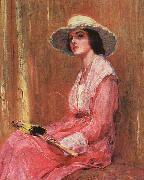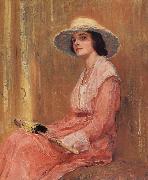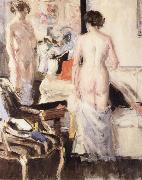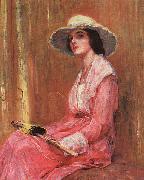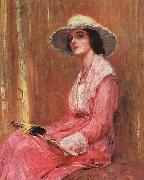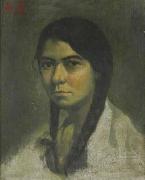Wholesale Oil Painting Reproductions No Minimum and Door to Door! |
|||||||||||
|
|
|||||||||||

|
|||||||||||
|
|
|
||||||||
All Guy Rose Oil Paintings |
||||||||
|
|
||||||||
|
|
||||||||
|
Artist Introduction: 1867-1925
Guy Rose Galleries
Guy Rose (3 March 1867?C17 November 1925) was an American Impressionist painter who is recognized as one of California's top impressionist painters of the late 19th and early 20th centuries.
Guy Orlando Rose was born March 3, 1867 in San Gabriel, California. He was the seventh child of Leonard John Rose and Amanda Jones Rose.
His father was a prominent California senator. He and his wife raised their large family on an expansive Southern California ranch and vineyard?? the San Gabriel Valley town of Rosemead bears the family name. In 1876 young Guy Rose was accidentally shot in the face during a hunting trip with his brothers. While recuperating he began to sketch and use watercolors and oil paints. He graduated from Los Angeles High School in 1884 and moved to San Francisco where he did his art training at the California School of Design.
In September 12, 1888, Rose enrolled at the Academie Julian in Paris and studied with Benjamin-Constant, Jules Lefebvre, Lucien Doucet and Jean-Paul Laurens while in Paris. In 1888-89, he won a scholarship at the Academie Delacluse. He met fellow students Frank Vincent and Frederick Melville at the Academie Julian -- Frank Vincent and Guy Rose were to remain lifelong friends.
Rose lived New York, New York in the 1890s and illustrated for "Harper's," "Scribners," and "Century". Choosing to return to France in 1899, he and his wife Ethel Rose bought a cottage at Giverny. In 1900 he resided in Paris and spent the winter in Briska, Algeria where he painted three known paintings. From 1904 to 1912 husband and wife lived in Giverny and his works from this period show the influence of "the master" Claude Monet, who became his friend and mentor.
In 1913-1914 the Roses summered in and held an outdoor sketching school at Narragansett, Rhode Island. Suffering on and off again from the effects of lead poisoning, Rose and his wife moved permanently to Los Angeles, California in 1914.
In Los Angeles, Guy Rose taught and served as Director of the Stickney Memorial School of Art in Pasadena. In 1921 he suffered a debilitating stroke that left him paralyzed. Guy Rose died in Pasadena, California on November 17, 1925. In 1926 the Stendahl Gallery held a memorial exhibition of his works. |
||||||||
|
|
||||||||
|
The Model Painting ID:: 4351 |
1919 |
|||||||
Height Width |
INS/CM Quality |
|||||||
|
X |
| |||||||
|
|
||||||||
All Guy Rose Oil Paintings |
||||||||
|
|
||||||||
|
|
||||||||
|
Artist Introduction: 1867-1925
Guy Rose Galleries
Guy Rose (3 March 1867?C17 November 1925) was an American Impressionist painter who is recognized as one of California's top impressionist painters of the late 19th and early 20th centuries.
Guy Orlando Rose was born March 3, 1867 in San Gabriel, California. He was the seventh child of Leonard John Rose and Amanda Jones Rose.
His father was a prominent California senator. He and his wife raised their large family on an expansive Southern California ranch and vineyard?? the San Gabriel Valley town of Rosemead bears the family name. In 1876 young Guy Rose was accidentally shot in the face during a hunting trip with his brothers. While recuperating he began to sketch and use watercolors and oil paints. He graduated from Los Angeles High School in 1884 and moved to San Francisco where he did his art training at the California School of Design.
In September 12, 1888, Rose enrolled at the Academie Julian in Paris and studied with Benjamin-Constant, Jules Lefebvre, Lucien Doucet and Jean-Paul Laurens while in Paris. In 1888-89, he won a scholarship at the Academie Delacluse. He met fellow students Frank Vincent and Frederick Melville at the Academie Julian -- Frank Vincent and Guy Rose were to remain lifelong friends.
Rose lived New York, New York in the 1890s and illustrated for "Harper's," "Scribners," and "Century". Choosing to return to France in 1899, he and his wife Ethel Rose bought a cottage at Giverny. In 1900 he resided in Paris and spent the winter in Briska, Algeria where he painted three known paintings. From 1904 to 1912 husband and wife lived in Giverny and his works from this period show the influence of "the master" Claude Monet, who became his friend and mentor.
In 1913-1914 the Roses summered in and held an outdoor sketching school at Narragansett, Rhode Island. Suffering on and off again from the effects of lead poisoning, Rose and his wife moved permanently to Los Angeles, California in 1914.
In Los Angeles, Guy Rose taught and served as Director of the Stickney Memorial School of Art in Pasadena. In 1921 he suffered a debilitating stroke that left him paralyzed. Guy Rose died in Pasadena, California on November 17, 1925. In 1926 the Stendahl Gallery held a memorial exhibition of his works. |
||||||||
|
|
||||||||
|
|
The Model Painting ID:: 36034 |
kr01
c.1919
Oil on canvas
24x20inches
|
||||||
Height Width |
INS/CM Quality |
|||||||
|
X |
| |||||||
|
|
||||||||
All Francis Campbell Boileau Cadell Oil Paintings |
||||||||
|
|
||||||||
|
|
||||||||
|
Artist Introduction: Scottish, 1883-1937, was a Scottish painter associated with the Scottish Colourists. Francis Cadell was born in Edinburgh and, from the age of 16, studied in Paris at the Academie Julian, where he was in contact with the French avant-garde of the day. While in France, his exposure to work by the early Fauvists, and in particular Matisse, proved to be his most lasting influence. After his return to Scotland, he was a regular exhibitor in Edinburgh and Glasgow, as well as in London. He painted landscapes, interiors, still life and figures in both oil and watercolour, but he is particularly noted for his portraits, depicting his subject with vibrant waves of colour. He enjoyed the landscape of Iona enormously, which he first visited in 1912 and features prominently in his work. |
||||||||
|
|
||||||||
|
|
The Model Painting ID:: 39359 |
mk147
c.1912
Oil on canvas
127.2x101.6
|
||||||
Height Width |
INS/CM Quality |
|||||||
|
X |
| |||||||
|
|
||||||||
All Guy Rose Oil Paintings |
||||||||
|
|
||||||||
|
|
||||||||
|
Artist Introduction: 1867-1925
Guy Rose Galleries
Guy Rose (3 March 1867?C17 November 1925) was an American Impressionist painter who is recognized as one of California's top impressionist painters of the late 19th and early 20th centuries.
Guy Orlando Rose was born March 3, 1867 in San Gabriel, California. He was the seventh child of Leonard John Rose and Amanda Jones Rose.
His father was a prominent California senator. He and his wife raised their large family on an expansive Southern California ranch and vineyard?? the San Gabriel Valley town of Rosemead bears the family name. In 1876 young Guy Rose was accidentally shot in the face during a hunting trip with his brothers. While recuperating he began to sketch and use watercolors and oil paints. He graduated from Los Angeles High School in 1884 and moved to San Francisco where he did his art training at the California School of Design.
In September 12, 1888, Rose enrolled at the Academie Julian in Paris and studied with Benjamin-Constant, Jules Lefebvre, Lucien Doucet and Jean-Paul Laurens while in Paris. In 1888-89, he won a scholarship at the Academie Delacluse. He met fellow students Frank Vincent and Frederick Melville at the Academie Julian -- Frank Vincent and Guy Rose were to remain lifelong friends.
Rose lived New York, New York in the 1890s and illustrated for "Harper's," "Scribners," and "Century". Choosing to return to France in 1899, he and his wife Ethel Rose bought a cottage at Giverny. In 1900 he resided in Paris and spent the winter in Briska, Algeria where he painted three known paintings. From 1904 to 1912 husband and wife lived in Giverny and his works from this period show the influence of "the master" Claude Monet, who became his friend and mentor.
In 1913-1914 the Roses summered in and held an outdoor sketching school at Narragansett, Rhode Island. Suffering on and off again from the effects of lead poisoning, Rose and his wife moved permanently to Los Angeles, California in 1914.
In Los Angeles, Guy Rose taught and served as Director of the Stickney Memorial School of Art in Pasadena. In 1921 he suffered a debilitating stroke that left him paralyzed. Guy Rose died in Pasadena, California on November 17, 1925. In 1926 the Stendahl Gallery held a memorial exhibition of his works. |
||||||||
|
|
||||||||
|
|
The Model Painting ID:: 78321 |
1919(1919)
Oil on canvas
cjr |
||||||
Height Width |
INS/CM Quality |
|||||||
|
X |
| |||||||
|
|
||||||||
All Guy Rose Oil Paintings |
||||||||
|
|
||||||||
|
|
||||||||
|
Artist Introduction: 1867-1925
Guy Rose Galleries
Guy Rose (3 March 1867?C17 November 1925) was an American Impressionist painter who is recognized as one of California's top impressionist painters of the late 19th and early 20th centuries.
Guy Orlando Rose was born March 3, 1867 in San Gabriel, California. He was the seventh child of Leonard John Rose and Amanda Jones Rose.
His father was a prominent California senator. He and his wife raised their large family on an expansive Southern California ranch and vineyard?? the San Gabriel Valley town of Rosemead bears the family name. In 1876 young Guy Rose was accidentally shot in the face during a hunting trip with his brothers. While recuperating he began to sketch and use watercolors and oil paints. He graduated from Los Angeles High School in 1884 and moved to San Francisco where he did his art training at the California School of Design.
In September 12, 1888, Rose enrolled at the Academie Julian in Paris and studied with Benjamin-Constant, Jules Lefebvre, Lucien Doucet and Jean-Paul Laurens while in Paris. In 1888-89, he won a scholarship at the Academie Delacluse. He met fellow students Frank Vincent and Frederick Melville at the Academie Julian -- Frank Vincent and Guy Rose were to remain lifelong friends.
Rose lived New York, New York in the 1890s and illustrated for "Harper's," "Scribners," and "Century". Choosing to return to France in 1899, he and his wife Ethel Rose bought a cottage at Giverny. In 1900 he resided in Paris and spent the winter in Briska, Algeria where he painted three known paintings. From 1904 to 1912 husband and wife lived in Giverny and his works from this period show the influence of "the master" Claude Monet, who became his friend and mentor.
In 1913-1914 the Roses summered in and held an outdoor sketching school at Narragansett, Rhode Island. Suffering on and off again from the effects of lead poisoning, Rose and his wife moved permanently to Los Angeles, California in 1914.
In Los Angeles, Guy Rose taught and served as Director of the Stickney Memorial School of Art in Pasadena. In 1921 he suffered a debilitating stroke that left him paralyzed. Guy Rose died in Pasadena, California on November 17, 1925. In 1926 the Stendahl Gallery held a memorial exhibition of his works. |
||||||||
|
|
||||||||
|
|
The Model Painting ID:: 81532 |
1919(1919)
Medium Oil on canvas
cyf |
||||||
Height Width |
INS/CM Quality |
|||||||
|
X |
| |||||||
|
|
||||||||
All Jose Ferraz de Almeida Junior Oil Paintings |
||||||||
|
|
||||||||
|
|
||||||||
|
Artist Introduction: (8 May 1850 - 13 November 1899) was a Brazilian painter of the 19th century. He is widely regarded as the most important Brazilian realist painter of the 19th century, and a major inspiration for the modernist painters. While most Brazilian academic artists made their fame painting mythological or historical subjects, Almeida Junior would become popular for painting rural figures, especially farmers and the caipira violeiro , the countrymen that are a kind of a symbol of the rural areas of the São Paulo state.
While most realist painters used farmers and countrymen as an allegory of workers, Almeida Junior would paint his caipiras mostly on leisure time. He would also produce touching images of upscale landowners. The Bandeirantes, the ruthless explorers of colonial Brazil, would be depicted in the A partida da monção, showing an expedition on the Tiete River.
Almeida Junior was born in the city of Itu, then a small town in the state of São Paulo. After becoming a sensation in his town he would be invited to study in the Brazilian Imperial Fine Arts Academy of Rio de Janeiro, but in 1876 would study in France after being granted a scholarship by emperor Pedro II of Brazil in person in the city of Moji-Mirim. He would have Alexandre Cabanel as one of his masters. In 1877 he was already enrolled in the School of Fine Arts in Paris. He took part at the Salon de Paris with several works of art in 1879 (Retrato do Dr. Jose de Magalhães), 1880 (O Derrubador Brasileiro) and (Remorso de Judas), 1881 (Fuga para o Egito) and 1882 (Descanso do Modelo) He admired the French realist and naturalist painting (a major influence at his work), and, after returning to Brazil in 1882, became of the leading names in Brazilian realist painting.
He was stabbed to death by the husband of his mistress on November 13, 1899 in Piracicaba.
|
||||||||
|
|
||||||||
|
|
The model Painting ID:: 98006 |
oil
Dimensions 46 x 38 cm
cyf |
||||||
Height Width |
INS/CM Quality |
|||||||
|
X |
| |||||||
|
|
||||||||
|
Prev Next
|
||||||||
|
|
||||||||
|
Related Paintings to Jose Ferraz de Almeida Junior :. |
||||||||
|
|
||||||||
|
CONTACT US |
